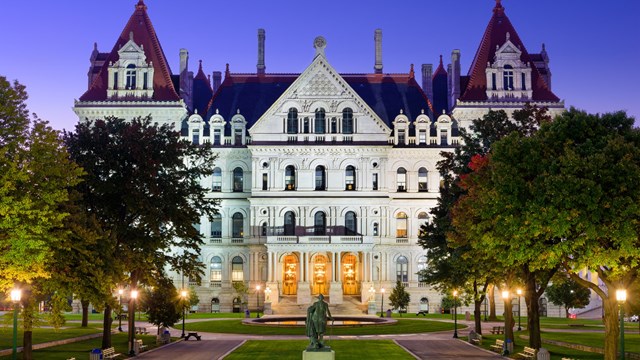On August 17, 2020, Governor Andrew Cuomo announced that all gyms and fitness centers in New York State may reopen for operation on Wednesday, September 2, 2020. (Indoor group fitness classes may be delayed beyond that date.) Upon reopening and until further notice, gyms and fitness centers are required to operate at sharply reduced capacity, and must strictly adhere to rigorous health and safety protocols, including requiring all users of the facility to wear masks at all times.
The purpose of this column is to outline the relevant New York State-mandated rules and regulations governing the reopening of gyms and fitness centers, and to analyze the potential liability for cooperatives and condominiums that opt to reopen their facilities in the midst of the ongoing COVID-19 pandemic.
Governance & Guidelines
In light of the fact that New York has achieved and maintained daily positive COVID-19 test results below 1%—meaning that each infected person passes the virus on to only one other person or less—the State has determined that local officials can allow gyms and fitness centers to reopen, so long as spaces are capped at 33% capacity and all users wear masks at all times. While gym-goers will no doubt greet this news with enthusiasm, it’s crucial to remember that even though COVID infection rates have been substantially reduced since the beginning of the pandemic—and certainly since its peak in NYC this past spring—the crisis is still very much ongoing. With no FDA-approved vaccine or drug yet available to combat the virus effectively, local health departments must strictly enforce guidelines to help protect the public, and ensure that gyms and fitness centers reopen safely—and residents must do their part by cooperating.
In order to provide sufficient time for required local health department inspections, local elected officials have jurisdiction in determining whether to delay the reopening of gyms and fitness centers past the September 2 date issued by the governor. Accordingly, in New York City, it is Mayor Bill de Blasio who will determine whether fitness facilities should postpone reopening. Outside of New York City, a given county’s chief executive—the county executive, administrator, manager, or chair of the local elected legislative body—will make that determination. Although Mayor de Blasio originally suggested that he would delay the reopening of fitness facilities in New York City past Governor Cuomo’s proposed date (continuing his ongoing feud with the governor), the Mayor ultimately agreed that gyms and fitness centers would indeed be cleared to reopen on September 2.
Local health departments must inspect gyms and fitness centers—either prior to their reopening or within two weeks of reopening, to ensure strict compliance with Department of Health (DOH) guidelines—and while facilities may open for individual workouts, the State’s guidelines allow localities to determine for themselves whether indoor group classes will be allowed to restart within their jurisdictions, or be postponed until a later date. At the time of this writing, Mayor de Blasio has maintained the ban on indoor group classes in New York City.
The Rules
The salient guidance for gym and fitness center reopening, whether public/commercial or private, such as might be found within a co-op or condo building, includes:
• Capacity: 33% occupancy limit
• Access: Sign-in with contact information and health/temperature screening required
• Personal Protective Equipment (PPE): Appropriate face coverings required at all times
• Distancing: Users must maintain at least 6 feet of separation at all times
• Hygiene/Cleaning: Cleaning and disinfection supplies must be made available to users; shared and/or rental equipment must be cleaned and/or disinfected after every use; staff must also be available to clean and disinfect equipment in between uses
• Group Classes: May be held by appointment/reservation only; class capacity must be capped to maintain 6-foot social distancing rules, but may in no case exceed 33% of the typical class size (i.e., by leaving some stations, cycles, etc. vacant); classes should be scheduled to allow additional time for cleaning and disinfection between each session
• Amenities: Shared water fountains may not be used; however, individual water bottle refill stations are permitted. Communal showers must remain closed, but individual showers/stalls may remain open, but must be cleaned between each use
• Air Handling Systems: Gyms’ air filtration systems should operate at MERV-13 rating or greater (filters at this level remove at least 90% of particles in 3-10 µm range, 85% of particles in the 1-3 µm range, and 50% of particles in the 0.3-1 µm range); if they are unable to operate at that level, they must bring in a heating, ventilation, and air conditioning (HVAC) professional to verify and document their inability to do so, and adopt additional ventilation and mitigation protocols endorsed by the American Society of Heating, Refrigerating and Air-Conditioning Engineers (ASHRAE) and the Centers for Disease Control and Prevention (CDC)
• Inspection: Local health departments shall inspect either before or within two weeks of the facility opening to ensure compliance
Liability Analysis
As we have seen, state and local governments across the country have undertaken extraordinary measures to combat the spread of COVID-19. Given the extremely high stakes, it should go without saying that the above-referenced safety guidelines must be strictly adhered to; in addition to putting people’s health in serious jeopardy, a cooperative or condo association that fails to do so could also face substantial liability. Generally, infection-based litigation is more of a concern for businesses operating in the healthcare sector, but these newly-adopted government mandates around the reopening of fitness facilities may expand this litigation to the cooperative and condominium sector.
In many states, violation of a law can constitute what is known as negligence per se. This means that the law—not a jury—sets the standard of care, and all a plaintiff has to do to establish negligence is show that the defendant violated the law. For example, that could mean demonstrating that the air handling system servicing the co-op or condo’s gym or fitness center isn’t operating at MERV-13 rating or greater, or that shared water fountains are still in use. Invariably, such failures would essentially relieve a plaintiff of the burden of having to prove that the defendant failed to act reasonably under the circumstances. Critically, the court can adopt a law—such as a social-distancing order, for example—as the standard of care where the purpose of that law is:
‘...to protect a class of persons which includes the one whose interest is invaded, and; to protect the particular interest which is invaded, and; to protect that interest against the kind of harm which has resulted, and; to protect that interest against the particular hazard from which the harm results.’ (See Restatement (Second) of Torts, § 286.)
For example, if individuals who use a gym in a co-op or condo building become infected with COVID-19 and subsequently become seriously ill, those individuals may be able to use the building’s failure to abide by the applicable rules and regulations for the reopening of fitness facilities to prove their case. In other words, if the building or association ignored a law that was specifically meant to protect people using the facility from COVID, and residents became ill with COVID as a result, that building or association may be held to the negligence per se standard, making it far easier for a plaintiff to prove its case and obtain damages.
One additional thing to note, however, is that New York recognizes negligence per se with regard to legislative orders—not executive directives—to define the standard of care. (See Elliott v. City of New York, 95 N.Y.2d 730 (2001). The mandates concerning the safe reopening and operation of gyms during the pandemic have been issued by the latter rather than the former, so it could be argued that since the legislature did not express a clear intent to impose private civil liability (such as a fine), a cooperative or condominium violating the regulations should not be subject to the less stringent standard of negligence per se. It will be interesting to see how future COVID-related personal injury cases take shape, and in particular whether the negligence per se standard is utilized in these future cases.
While it may prove difficult to link a specific COVID-19 infection to a building’s failure to abide by an applicable gym reopening mandate, and while there will be obvious issues of contributory and comparative negligence (did the individual wear a mask while working out, properly socially distance, wash their hands, etc.?), co-ops and condos should nevertheless strictly adhere to the gym reopening rules, and—given that most such facilities are smaller, confined indoor spaces—consider mandating even stricter guidelines in order to reduce potential future liability. Additionally, boards may also want to consider having an inspection performed by the local health department to ensure proper compliance with all salient rules and regulations prior to reopening.
For those boards that do elect to reopen their gyms during the pandemic, it may be wise to consider closing those facilities during certain hours in order to do a regular deep cleaning of the space and its contents—particularly the high-touch surfaces such as furniture, doorknobs, handlebars, and railings. If it’s simply not feasible for staff to be on-hand to enforce masking, monitor sign-in sheets, limit capacity, and constantly clean and disinfect equipment, or for gym equipment to be properly spaced out, or to confirm that the building’s air handling system is operating within proper guidelines, the prudent course of action would be for the board to simply not reopen the building’s gym at all.
Massimo F. D’Angelo is a partner at the New York City-based law firm of Adam Leitman Bailey, P.C., and is admitted to practice before the state courts of New York and New Jersey, and the U.S. District Courts for the Southern District and the Eastern District of New York and the District of New Jersey.










Leave a Comment